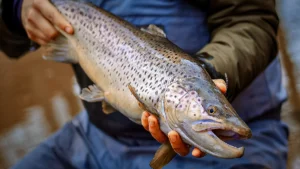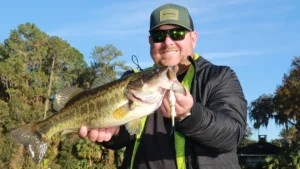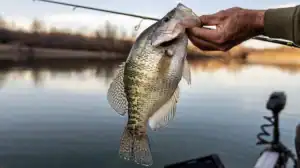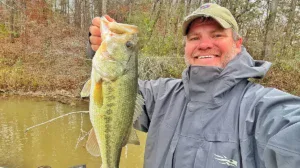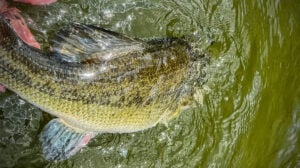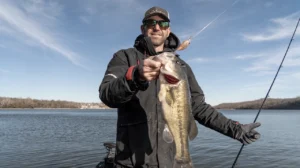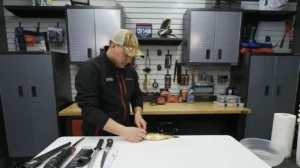As the shad begin their annual migration to the backs of creeks in the fall, anglers are provided with a unique opportunity to break out their shallow fishing tackle and load the boat with chunky bass. As fishing pressure increases and the bass become wary towards the constant barrage of noisy crankbaits, jerkbaits and topwater plugs, a quieter, more natural approach is often a large key to success.
Situations like this are when soft-plastic jerkbaits like Zoom Super Flukes can prove to be worth their weight in gold. It’d be nearly impossible to find a bass fisherman who is unfamiliar with Super Flukes, as their subtle, darting action and outstanding castability have caught big bass for anglers all over the world. While they will certainly catch fish all year round, Flukes are a “must have” throughout the autumn fishing season.
Key areas
Flukes will catch fish in almost any situation, but to maximize your success throughout the fall, locating the bait is of the utmost importance. While many professionals rely on advanced electronics in tournament situations, sharp eyes and keen observance are often all that’s necessary. As you survey the water, pay close attention to any surface disturbance, as it could be indicative of bait activity. When targeting bass, especially in the fall, they will never stray far from the bait.
Secondary points are great areas to target throughout the fall season. During the fall migration, both shad and bass will often stage on secondary points before they move towards the back creek flats. As bass are opportunistic predators, they will position themselves on these points while waiting for big balls of shad to pass by. When the opportunity is right, the bass will ambush unsuspecting prey.
As autumn continues, shad will leave the secondary points and inhabit the shallow creek flats. If you’re not sure when this occurs, don’t worry—it is pretty difficult to miss. Keep an eye out for any shad flickering on the surface, because it will often look like you can walk across the water on shad. Even if only a few shad are on the surface, thousands more can be below them, so any surface activity is worth a few casts.
It’s pretty tough to get “too shallow” in the fall. When the time is right and the shad are stacked in the backs of creeks, never hesitate to throw a fluke into dirt-shallow water. During the day, feeding bass will periodically move up into the shallows to feed on susceptible shad, so if there is deep water nearby, don’t be afraid to kick up a little mud and go shallow.
Presentation is everything
There are a few specific presentations that we have found to be especially effective for fall Fluke fishing. When the sun is high and the balls of shad are pushed deeper in the water column, a slower, more methodical approach is pretty tough to beat. In order to get the Fluke into the optimum strike zone, it is essential to let it sink for long periods of time. Following a long cast, start out by letting it sink for a few seconds and retrieving with a slow, sweeping motion.
This method can be difficult to master, due to the difficulty in detecting bites—you really need to become a “line watcher” in order to catch the bass before it feels you on the other end. Even the slightest twitch or jump in your line calls for a hookset.
During lowlight conditions, however, shad become much more active and remain higher in the water column for longer periods of time. Situations like this are especially exciting as it allows for a faster, much more erratic retrieve. I like to make very long casts and work the Fluke just as I would a hard jerkbait, with a “jerk-jerk-pause” retrieve. Be careful, however, when you’re popping your rod tip, because if you do it too hard, it is very possible to rip the bait out of the fish’s mouth. The softer you work the bait, the earlier you will be able to detect bites.
Regardless of the weather conditions, every effort needs to be made to land the Fluke softly onto the water’s surface. When surrounded by sometimes millions of live shad, loud or unnatural noises can often spook both the bait and bass, which can make catching fish very difficult. A side armed roll cast is best, as it allows the Fluke to seamlessly enter the water, while also emulating a fleeing shad. With the Super Fluke being so streamlined in its design, this technique takes just a short period of time to master.
Check out why it made it on our list of Five Fall Fishing Lures for Under $6 a Piece.
Downsize your gear
As much fun as it can be to catch big bass on heavy tackle, it doesn’t always work. Light tackle is always a necessity when Fluke fishing in order to obtain maximum castability and optimum performance. While it is, in fact possible to work a fluke on bait casting gear, spinning gear offers anglers an easier starting point. And with the better light braids on the market, you can make long casts and still get good hook sets without sacrificing pound strength in your line by using braid with Flukes.
Fluorocarbon also works well with Flukes because the sinking nature of the line can make it easier to get the bait down a bit to the bass and the clear properties make it a great alternative to braid in ultra-clear water.
A 3/0 EWG hook is also hard to beat on a Fluke. Many anglers believe you have to have a big hook but a 3/0 hook covers the bases well for fishing with soft jerkbaits.
Colors
Color selection is always one of the most important factors to successful fishing, and it is no different when fishing with Flukes in the fall. In sunny or clear water situations, we opt for much more natural colors, such as White Ice or Smokin’ Shad. Because bass are able to see the bait from much further away in these conditions, it is important to imitate their natural forage to the best of your ability. If the bite is super tough and the fish are being stubborn, I love to take a Sharpie marker and draw the characteristic dot of a threadfin shad onto my flukes. Anything that adds realism and increases your confidence is always worth doing.
In cloudy or stained water situations, brighter colors can prove to be very effective. Although it may not look like a shad to us, that doesn’t mean it won’t fool a big bass in the middle of a feeding frenzy. Green Pumpkin and Chartreuse colored Super Flukes are great for these conditions. Because Flukes are largely a sight-oriented bait, I love using Chartreuse in order to keep track of the bait and see strikes long before I see them.
If the bass aren’t interested in your hard baits this fall, don’t be afraid to downsize by throwing a soft jerkbait, like one of our favorites, the Zoom Super Fluke, at them. It’s an awesome sight to see a big bass boil on top of a Fluke—something that will probably become quite addicting. Great for both advanced anglers and bank fishermen, a Fluke will catch some really big fish. Targeting the correct areas with the correct presentation, gear and color selection has the potential to yield some outstanding results this fall.
The area between the thumb and index finger is called the thenar space. The skin is called webbing.
If you love to shred your thenar space and tear up your webbing, you are Wired2Fish!



